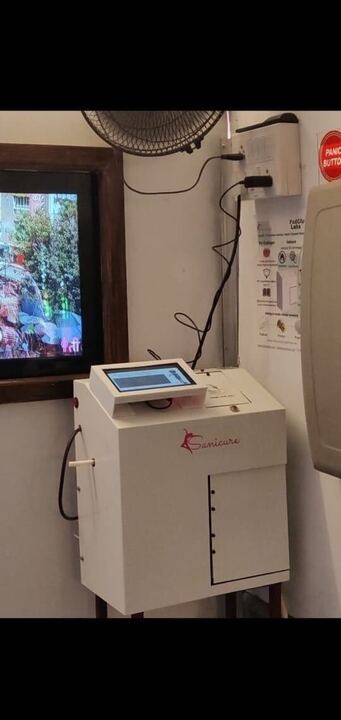Pune Startup’s Innovation Breaks Down Used Sanitary Pads Without Burning Them
Pad Care labs, a Pune-based startup has launched an eco-friendly sanitary waste collection, and disposal system that prevents used pads from entering landfills and incinerators.

Did you know that 353 million women and adolescents in India use sanitary pads, which, in turn, generates up to 125 kgs or more of waste through their menstruating years?
Sanitary pads are typically disposed of in two ways — they are either buried in landfills, and that takes 500-800 years for them to decompose each — or are burned in incinerators that release toxic fumes like dioxins, phuron, and other carcinogenic compounds into the atmosphere.
To address this problem and introduce an eco-friendly sanitary waste disposal system, Pad Care Labs, a Pune-based startup, has launched a waste collection, and disposal system called ‘SaniBin’ and ‘SanEco.’ Through this system, sanitary pads can be converted into two residual compounds such as cellulose and plastic pellets.
About the Startup
In 2017, Ajinkya Dhariya, a student of mechanical engineering from Shri Guru Gobind Singhji Institute, Pune, was working on a project in the waste management sector. First, he conducted market research to understand what were the sustainable solutions for disposing of sanitary waste and biomedical waste.

“In India, there are two methods used for the disposal of these two categories of waste — burying in landfills, or incineration. But neither of them are eco-friendly,” says Ajinkya.
After graduating, he briefly worked as a part of a Research and Development team with a manufacturing company in Aurangabad, which gave him the experience, and knowledge to develop technology and build solutions. In 2018, while Ajinkya was still working in the manufacturing company, he got the opportunity to submit a business idea about how to tackle and dispose of sanitary waste, in a competition conducted by the Biotechnology Industry Research Assistance Council (BIRAC)
“My paper was among the top 10 entries, and this prompted me to start my venture –Pad Care Labs — and work towards developing solutions to tackle hazardous waste. Along with a team of six members, we started to work on a machine that could help dispose of sanitary waste without harming the cleaning staff, and the environment. The startup was incubated by Venture Center, Pune, and Unlimited India that nurtures early-stage startups.”
Ground Research
In 2018, to offer a disposal solution at the source, the team started conducting ground research to understand the problems women face during disposal of sanitary waste. They started by speaking to Ajinkya’s mother, and then their own family members, friends, and eventually with educational institutes at the school and university-level.
After gathering responses from more than 1000 women in educational institutes, Ajinkya identified several problems faced by users trying to dispose of sanitary products and the cleaning staff that handle them later.
“Most users mentioned that they felt uncomfortable carrying a sanitary napkin outside the toilet cubicle and disposing of it in a common dustbin. In the absence of a dustbin inside the cubicle, many opted to flush it down the toilet, which led to clogged drains. Even if there was a dustbin to throw the waste within the cubicle, many would throw the pads without wrapping them in the newspaper which led to bad odour, and an unhygienic environment. The cleaning staff complained of the smell, and skin irritation they faced from handling open pads,” says Ajinkya, adding that an educational institution generates a minimum of 25 to 30 pads every day and a minimum of 100 sanitary napkins in office spaces.
As already mentioned at the start of this article, these are either sent to landfills or to incinerators that burn these pads and in turn release carbon dioxide, and other carcinogenic compounds into the atmosphere.
“Some large offices have installed their incinerators to dispose of sanitary pads, but many women are not comfortable carrying their used pads outside the bathroom. So the solution proved ineffective,” says Ajinkya.
A Safe Disposal Solution for Sanitary Pads
To provide a solution that would act as a waste collection, and disposal system, Ajinkya and his team built- ‘SaniBin’ and ‘SanEco’.
SanEco is a one-of-a-kind waste management system that works on a chemical and mechanical disintegration method.
First, the sanitary pads which are disposed of by users are collected in the ‘SaniBin’ which are placed inside toilet cubicles.
“SaniBins have individual liners inside which collect up to 30 sanitary pads over 3 weeks. Each liner is equipped with a patent-pending disinfection system that acts as a bacteria lock, and prevents producing any bad odour.”

Then, the liners holding the sanitary pads are fed into ‘SanEco’. In this system, the pads are disintegrated into smaller bits through a mechanical shredder.
The shredded pieces undergo a disinfection, decolourisation, deodorization process before it is finally deactivated. This process involves using sodium polycarbonate to deactivate the super-absorbent chemical from the sanitary pads.
Finally, it is broken down and separated into cellulose, and plastic pellets. Ajinkya claims that the cellulose can be used to make paper, and the plastic pellets can be used to manufacture packaging material or construction material. The blood and other body fluids are also broken down in the same process and removed through a separate outlet as sewage.

Ajinkya says, “This sewage was tested by the National Accreditation Board for Testing and Calibration Laboratories (NABL), and the bacterial load was within the limits prescribed by the Central Pollution Control Board (CPCB). So this liquid can be directed into regular sewer lines. The other residual compounds – Cellulose and Plastic pellets can be used to manufacture products like packaging material, construction material, and paper.”
Pilot Testing
In 2019, the team began testing their product and installed ‘SaniBin’ boxes in public toilets across Pune, and educational institutes such as Cummins College for Women and Indian Institute of Science Education Research (IISER), Pune, to collect the sanitary pads.
Ulka Sadalkar, the co-founder of Saraplast Pvt Ltd, a company that launched pink buses converted into toilets for women in Pune, says, “There were three bins set up in different toilets on the buses. It was such a good system as it produced no odour, and blended well with the rest of the bathroom. It did not occupy much space, and women found it very comfortable to drop their sanitary pads discreetly. Ajinkya and his team would collect the sanitary pads in regular intervals, and continued to do the same until the lockdown was announced.”
Ajinkya says, to date, these bins have been accessed by more than 950 women and 20 waste collectors. More than 2400 pads have been disposed of in the system which has prevented 4 metric tonnes of carbon dioxide from entering the atmosphere.
While the centralised devices are still in the pre-commercial stage, the manufacturing of the final version is in process and will be completed by October. Ajinkya is also working on solutions to set this up in metropolitan areas and rural areas across the country. He had to put a hold on manufacturing new units owing to the lockdown. But, if you wish to know more you can visit his website, or email him at [email protected].
(Edited by Gayatri Mishra)
If you found our stories insightful, informative, or even just enjoyable, we invite you to consider making a voluntary payment to support the work we do at The Better India. Your contribution helps us continue producing quality content that educates, inspires, and drives positive change.
Choose one of the payment options below for your contribution-
By paying for the stories you value, you directly contribute to sustaining our efforts focused on making a difference in the world. Together, let’s ensure that impactful stories continue to be told and shared, enriching lives and communities alike.
Thank you for your support. Here are some frequently asked questions you might find helpful to know why you are contributing?


This story made me
-
97
-
121
-
89
-
167













